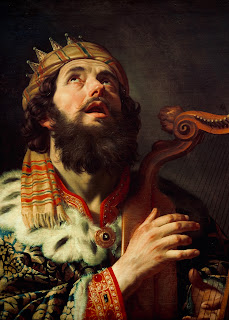(The Holy Family of Jesus, Mary and Joseph; This homily was given on December 30 & 31, 2023 at Saint Augustine Church in Providence, Rhode Island; See Genesis 15:1-6; 21:1-3, Hebrews 11:8-19 and Luke 2:22-40)
Virtues of Family Life
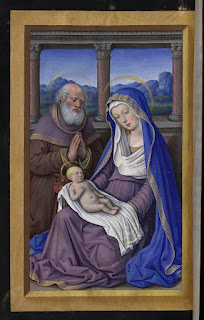



As 2023 comes to a close, moviegoers are reflecting on their most exciting cinema experiences of the year, despite the complications of the SAG-AFTRA strike. « Barbie » smashed box offices and women’s hearts as stereotypical Barbie (played by Margot Robbie) journeyed from Barbieland into the real world. Spiderman enthusiasts enjoyed another adventure in « Spider-Man: Across the Spider-Verse » as teenage Miles Morales teamed up with Spider-Woman, Gwen Stacy. Faith-based movies surprised many people, as « Jesus Revolution » and « Sound of Freedom » exceeded expectations at the box office, proving that faith-based films are just as wanted in theaters as secular movies.
The new year will bring more anticipated movies filled with joy, laughter, endurance, conversational topics and the light of God. If you’re wondering what to watch in 2024, we have you covered.
End the year by witnessing two great minds debate the existence of God and human nature. The film depicts a fictional debate set in 1939 between Sigmund Freud (Anthony Hopkins) and C.S. Lewis (Matthew Goode). « Freud’s Last Session » was originally a play by Mark St. Germain. The film is directed by Matt Brown, known for « London Town, » « Ropewalk » and « The Man Who Knew Infinity. »
« Freud’s Last Session » is an undeniably serious film, but thoughtful moviegoers will appreciate the father of psychoanalysis debating the nature of God with the author of The Chronicles of Narnia. The film debuted on Oct. 27 at the 2023 AFI Film Festival.
« The Book Of Clarence » is certain to be a topic of conversation among Christians and secular people alike this January. This fictional period piece is set during the time of Jesus’ ministry and follows Clarence, a down-on-his-luck Jerusalemite who attempts to profit from the Messiah’s fame and power. His journey takes him down an unexpected road of faith and self-discovery.
The movie is directed by Jeynes Samuel, who also directed the smash 2021 hit « The Harder They Fall. » Clarence is played by LaKeith Stanfield, who recently acted in Disney’s « Haunted Mansion. » Other cast members include Teyana Taylor, James McAvoy, Benedict Cumberbatch, Omar Sy and RJ Cyler.
Director Samuel has always believed that great stories can be told around biblical times.
« I’ve always loved those things where they kind of take a bit of liberty with the Bible because the story runs alongside it, » Samuel said in a Deadline Q&A. « A man trying to prove he’s a nobody, a man that believes he can do anything. And this belief gets him in trouble with the neighborhood terrorists, so to speak. Then he ends up on a path of self-discovery, redemption, and awakening. I know I could tell a great story like that, but set in a biblical era, it would just be something to marvel at. »
The film will be released in theaters Jan. 12.
The story of the King of Reggae is coming to the big screen. « Bob Marley: One Love » will cover the legendary singer’s life from 1976 to 1978, celebrating, as Paramount Pictures puts it, « the iconic artistic work that has inspired love and unity for generations. »
Reinaldo Marcus Green directs the movie. Kingsley Ben-Adir (« Barbie, » « Secret Invasion ») plays Bob Marley. Lashana Lynch, who held roles in « The Woman King » and « The Marvels, »
plays Rita Marley, the wife of Bob Marley. This movie is a family affair; the film’s producers include members of the Marley family: wife Rita Marley, son Ziggy Marley and daughter Cedella Marley all contributed to the film.
« We talk all the time. Every step of the way, the script, the casting, the hair, the makeup, » Green said in an interview. « I want this to be for people who know and love Bob and who can still find out things about his life that they didn’t know, as well as introducing him to a new generation. »
The film is set to be released in theaters on Feb. 14.
Sometimes, ordinary people do extraordinary acts of good. The film « Ordinary Angels » depicts the true story of the Schmitt family’s struggle to find a liver transplant for their youngest daughter with the help of a passionate and determined hairdresser, Sharon Stevens.
Oscar-winner Hilary Swank plays Sharon Stevens. The Schmitt patriarch is played by Alan Ritchson, who plays the lead in the hit Amazon Prime show « Reacher. » Jon Gunn directed the film.
Kevin Downes, a producer on the film, told the Washington Examiner that he hopes the film inspires people to « not just talk about how we can love our neighbor, but actually show how we can love our neighbor in ways that put others in front. »
Even the actors feel the hope radiating from the film.
« I was drawn to this beautiful true story because it’s such a powerful reminder that angels reside everywhere among us, » Swank said in a statement to today.com. « And that faith, hope, grit, and positivity are all powerful fuel for miracles. »
This story will inspire hope and remind people that God still uses everyday people for extraordinary miracles.
« Ordinary Angels » will hit theaters on Feb. 23.
« Arthur The King » tells a story of endurance and a great friendship between a man and his dog. Michael (Mark Wahlberg) prepares for a tough race across the Dominican Republic with his team of adventure athletes. During the grueling race, Michael runs into the same stray dogs he had met hundreds of miles prior.
« Arthur the King » is based on the true story of Mikael Lindnord, told in his 2017 book Arthur: The Dog Who Crossed the Jungle to Find a Home. Lindnord was captain of the Swedish team Peak Performance in the 2014 Adventure Racing World Championship in Ecuador, where he met Arthur. Lindnord later adopted Arthur and took him back to Sweden.
The cast includes Simu Liu, Juliet Rylance, Nathalie Emmanuel, Ali Suliman and Paul Guilfoyle. Simon Cellan Jones directs the film.
Arthur has since passed away, but will never be forgotten by his family.
« Arthur’s beautiful soul touched many people; for us in the family, he was the best family member you could dream about, » Lindnord said in a statement. « He was like a guardian angel to our kids. »
Moviegoers can catch this inspiring story in theaters on March 22.
Advertisement
« Ghostbusters: Frozen Empire »
Ghostbusters are back to fight off a chilling new ghost. Paul Rudd, Carrie Coon, McKenna Grace and Finn Wolfhard have reprised their roles from 2021’s « Ghostbusters: Afterlife. » The original cast also joined in the fight against this icy new ghost. Stars Bill Murray, Dan Aykroyd, Ernie Hudson and Annie Potts are seen in the trailer. Gil Kenan directs the film.
« It’s an absolute honor to pick up the proton pack and step behind the camera for the next chapter of the Spengler family saga, » writer and exec producer Gil Kenan told Deadline. « I just wish I could go back to 1984 and tell the kid in the sixth row of the Mann Valley West that one day he was going to get to direct a ‘Ghostbusters’ film. »
Fans of the Ghostbusters franchise can enjoy the newest installment in theaters on March 29.
Fans have been saying his name since 1988. Now, the wait is over. He’s back! « Beetlejuice 2 » will star Michael Keaton, Winona Ryder, Alec Baldwin, Geena Davis, Catherine O’Hara and Jenna Ortega. Tim Burton will direct the film.
Keaton, who plays Beetlejuice, is excited to keep aspects of the movie similar to the original.
« We both agreed, if it happens, it has to be done as close to the way we made it the first time, » Keaton said of his discussions about the sequel with Burton. « Making stuff up, making stuff happen, improvising and riffing, but literally handmade stuff, like people creating things with their hands and building something. »
Fans will be able to see the lovable and funny poltergeist again on Sept. 6.
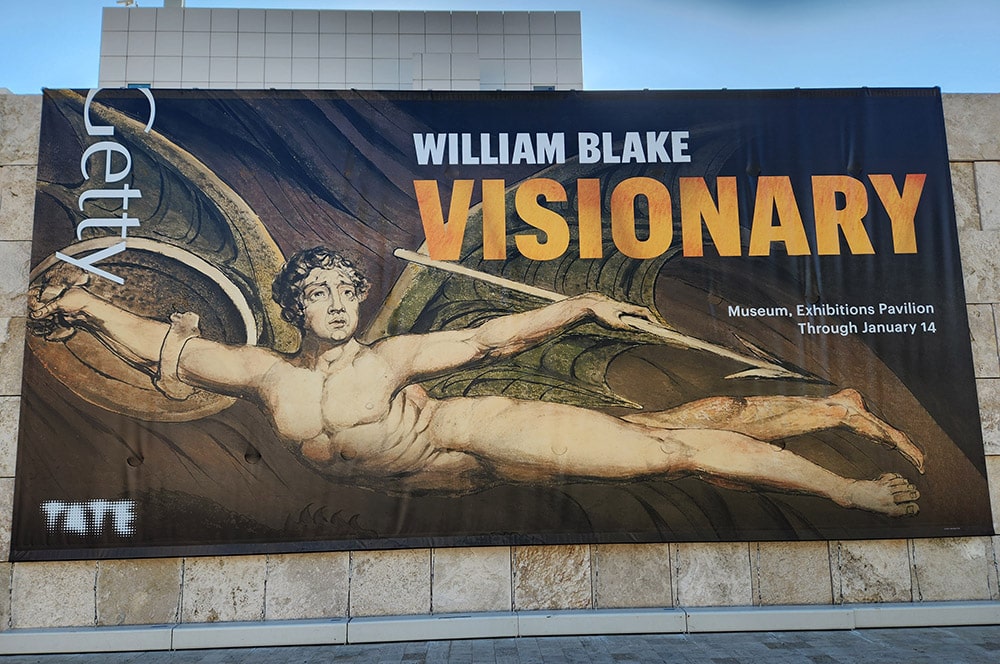

My encounters with the work of the early English Romantic painter, engraver and poet William Blake (1757-1827) have been marked by respect, awe and sometimes bewilderment.
Respect and awe because both Blake’s poetry and visual art are grounded in a unique, single-minded perspective that, to the reader and art lover, are not easily categorized — visionary, spiritual, aspirational, remarkable in their moral integrity.
But those are also the reasons that sometimes, particularly in the visual work of prints and paintings, Blake’s unconventional visual art can bewilder and confound.
And that’s all right, as I found out during a recent afternoon at the J. Paul Getty Museum, which is currently hosting a major exhibition on Blake’s work titled « William Blake: Visionary, » now on view at the Los Angeles museum through Jan. 14, 2024.
William Blake’s religious views were complex, even contradictory.
« Radical, fantastical, and unforgettable, » Timothy Potts, the director of the museum said in a statement about the exhibit. « Blake’s works will make visitors feel they have been transported to another world. »
They do — and in ways that can make an art lover feel spiritually renewed.
More than 100 works are on display in this collaboration with the famed Tate Britain in London. The Getty’s « William Blake: Visionary » is being called the first major international loan exhibition on Blake on the U.S. West Coast — an event that had been originally slated to open in 2020 but was delayed due to the global pandemic.
It was worth the wait. I’ve seen some of the works before, including at the Tate, but it was inspiring to see so many Blake works exhibited together.
In exploring what the Getty calls « Blake’s wild imagination, » the exhibit gives proper grounding to his historical context. As noted by art scholars Edina Adam and Julian Brooks in their introduction to a catalog accompanying the exhibit, the Great Britain of Blake’s era underwent « significant political, economic and social changes, » including three major military conflicts on five continents. Among those conflicts, of course, was the 1765-83 American Revolution.
Religious divisions, too, marked the era. As the introduction notes, Catholics, Jews and dissenting Protestants — those who « did not conform to the practices of the Anglican Church » — had limited rights, which was also true of all women and of men who were not property owners.
But the era was perhaps most marked by some of the same contradictions and challenges of our own time. Though Great Britain experienced great prosperity, the catalog’s introduction notes that « wealth was distributed unequally, and the disparity between the classes grew, resulting in social unrest. »
« Blake bore witness to these changes, » Adams and Brooks note, and saw London transformed into a megalopolis in which the traumas of economic disparity were glaringly apparent.
Some of this was expressed vividly in poetry that often took a bold turn from much of the neoclassical verse of the 18th century. Blake’s work became grittier — not afraid to offer social critique, as the first two stanzas of Blake’s 1794 poem « London » demonstrate:
I wander thro’ each charter’d street,
Near where the charter’d Thames does flow.
And mark in every face I meet
Marks of weakness, marks of woe.In every cry of every Man,
In every Infants cry of fear,
In every voice: in every ban,
The mind-forg’d manacles I hear
In this and other ways, Blake — whose own family were Protestant « dissenters » — took on both the political and religious powers of his time and wasn’t afraid to be contrarian and embrace novelty.
Advertisement
It shouldn’t surprise that while Blake was educated at the prestigious Royal Academy of Arts, he always felt himself to be an outsider and chose not to embrace the popular genre of oil painting, which won acclaim for his contemporary J.M. William Turner (1775-1851).
I find that a bit sad — no one can question Blake’s talent and versatility in printmaking, tempera and watercolor, but imagine what he could have done had he embraced oil painting — and on the scale Turner so masterfully pulled off.
As it is, the Getty exhibit does a fine job of exploring Blake’s spiritual vision — which had its roots in Christian and classical imagery, but was singularly unique. Blake turned to the Bible for inspiration — the exhibit has no shortage of biblically inspired images, such as « The Death of the Virgin, » an 1803 watercolor, and « Satan Exulting over Eve, » a 1795 print that serves as something of the exhibit’s centerpiece.
As the Getty notes in its description of the exhibit, Blake’s religious views were complex, even contradictory. Blake rejected the idea of God « as an omnipotent patriarch or vengeful deity, » the museum said. « Rather, he identified as a spiritualist and claimed to have experienced frequent visions. »
Something of Blake’s spirit comes alive in a self-portrait on display — a work that suggests an alert, intense man intent observing the world around him with a hypnotic, straight-ahead gaze.
To many, Blake was a forerunner of counterculturalism.
« William Blake’s deep spirituality, questioning nature, and vivid imagination particularly resonated with poets and musicians of the 1960s and 1970s such as Allen Ginsberg, Patti Smith, and Bob Dylan, » said Brooks, who is the Getty’s senior curator of drawings. « Yet Blake’s work continues to pop up in many unexpected places too, and it feels eternally relevant. »
As a poet, I found Blake’s printmaking that combined his original verse with intricate detailed images— a genre he called « illuminated books » — arresting. What poets would not want their verse illustrated with such care and love?
But for me, the exhibit’s highlight was Blake’s masterful prints of the story of the Book of Job. I kept returning to them again and again during the afternoon I spent at the museum. Beautifully detailed, these works display both humanity and majesty.
In depicting a well-known Biblical narrative of a man beset by suffering and despair, Blake’s Job is rendered with a cosmic backdrop — both moving and stirring.
Brooks said the museum hopes « William Blake: Visionary » will leave visitors « feeling empowered to explore the boundaries of what can be imagined. »
Thanks to the Getty and to William Blake, I certainly did.
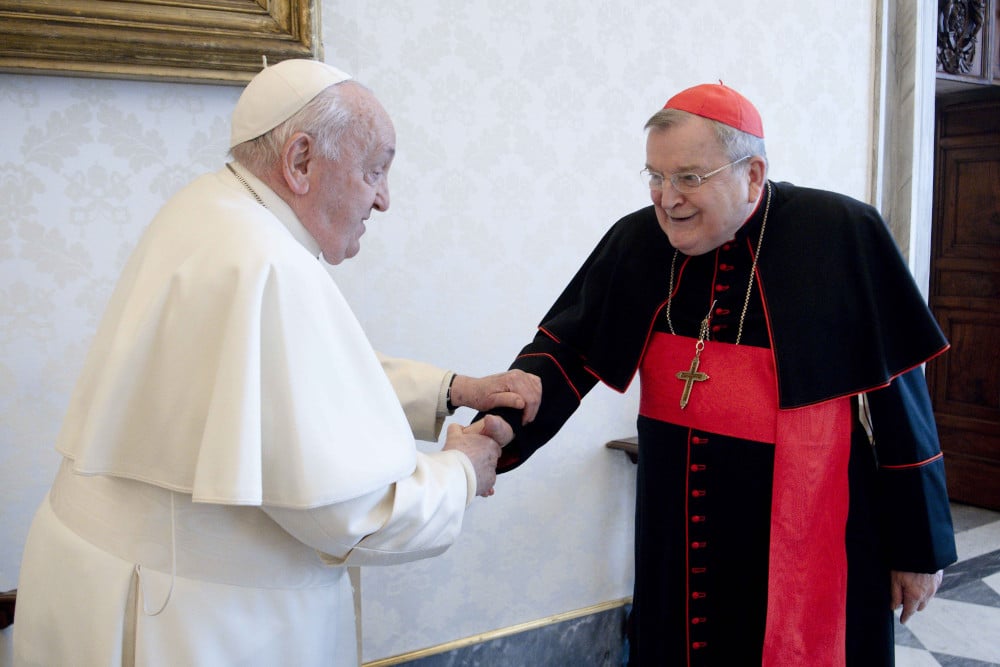

U.S. Cardinal Raymond L. Burke, a former top Vatican official, met privately with Pope Francis Dec. 29, about a month after reports that Francis wanted to stop giving him a monthly salary and would ask him to pay the market rate for his Vatican apartment.
The Vatican press office provided no information on the meeting other than to announce it had taken place.
Reached at the cardinal’s apartment, his secretary told Catholic News Service, « His Eminence wishes to give no comment at this time. »
During a meeting Nov. 20 with the heads of the offices of the Roman Curia, Francis reportedly informed the Curia leaders of his plan. Various reports say Burke is expected to find his own apartment in Rome and move out of the Vatican accommodations by the end of February.
Francis « didn’t see why he should continue to subsidize Burke attacking him and the church, » and the pope thought « he seemed to have plenty of money from America, » a person who spoke to Francis told Catholic News Service.
Burke, 75, is the former head of the Apostolic Signatura, the church’s highest court. Before Pope Benedict XVI appointed him to that role, he had served as archbishop of St. Louis.
In 2016, Burke and three other cardinals publicly released a critical set of questions, known as « dubia, » that they had sent to Pope Francis about his teaching on the family. They published the questions after waiting in vain for two months for a response from the pope.
A few days before the Synod of Bishops on synodality opened in October, Burke and four other cardinals released another set of « dubia » that they had sent the pope seeking clarification on doctrinal and pastoral questions expected to be raised at the synod. They did not release the pope’s responses to them, but the Dicastery for the Doctrine of the Faith did later.
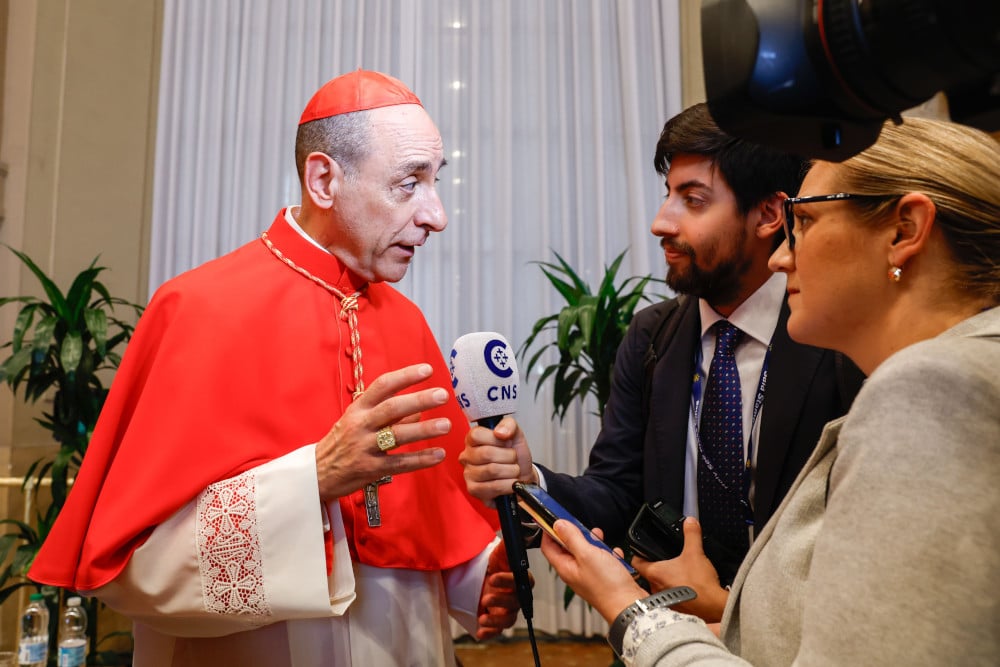

The Vatican’s affirmation that a priest can give an informal blessing to a gay couple that asks for one is not a first step toward the Catholic Church recognizing same-sex marriages, said Cardinal Víctor Manuel Fernández, prefect of the Dicastery for the Doctrine of the Faith.
« Those who say so either have not read the text or have ‘bad blood,’ if you will pardon the expression. The statement clearly and ad nauseam states that these blessings are non-ritualized so that they are not interpreted as a marriage, » the cardinal told the Spanish newspaper ABC in an interview published Dec. 25.
The doctrinal dicastery’s document, Fiducia Supplicans (« Supplicating Trust »), which was approved by Pope Francis, said that while the church « remains firm » in teaching that marriage is only a life-long union between a man and a woman, in certain circumstances priests can give non-sacramental, non-liturgical blessings to « couples in irregular situations and same-sex couples without officially validating their status or changing in any way the Church’s perennial teaching on marriage. »
Several bishops’ conferences in Africa and elsewhere reacted strongly against the document, which was published Dec. 18, and issued statements forbidding their priests from offering such blessings.
While Fernández insisted the document « upholds with great clarity and simplicity the Catholic teaching on marriage and sexuality, » he said bishops have a right and duty to advise their priests on the possible use of such blessings.
« What they (African bishops) raise is the inappropriateness of performing blessings that could easily be confused with a legitimization of an irregular union in their regional contexts, » he said.
In addition, he said, several African nations have laws that « penalize with imprisonment the mere fact of declaring oneself gay, » so it would be difficult to imagine a priest in those countries giving a gay couple a blessing.
« In reality, » the cardinal said, « it is up to each local bishop to make this discernment in his diocese or in any case to give further guidance. »
In other situations, Fernández said, people reacting negatively to the document simply did not read it.
« The central theme of the document is the value of ‘non-liturgical,’ ‘non-ritualized’ blessings, which are not a marriage, they are not an ‘approval’ or a ratification of anything, » he said. « They are simply the response of a pastor to two people who ask for God’s help. And, in this case, the pastor does not set any conditions. »
Blessing two people who ask for God’s help is not accepting their relationship as a marriage, « nor is it a ratification of the life they lead, nor is it an absolution, » the cardinal said. « It is a simple gesture of pastoral closeness that does not have the same demands that a sacrament has. »
« If a priest gives this kind of simple blessing, he is not a heretic, he is not ratifying anything, nor is he denying the Catholic doctrine on marriage, » Fernández said.
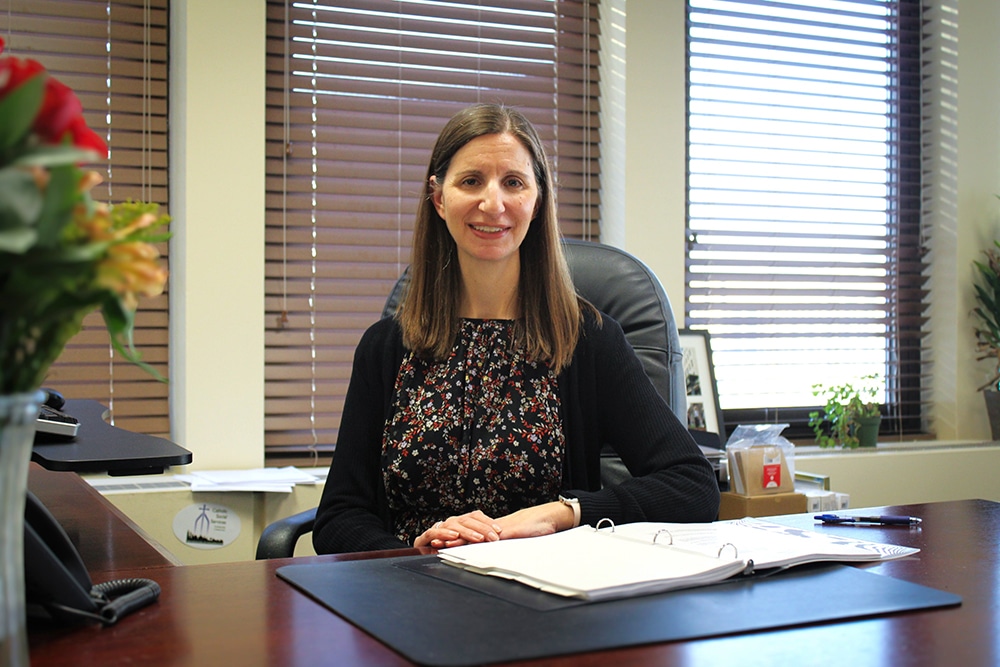

As Pope Francis seeks to include more women in key church leadership positions, a Catholic social worker has been named to a pioneering post for women in the Archdiocese of Philadelphia — and a number of women have inspired that historic journey, she told OSV News.
Archbishop Nelson Pérez of Philadelphia announced Dec. 1 the appointment of Heather Huot as that archdiocese’s secretary for Catholic Human Services, overseeing three agencies — Catholic Social Services, Catholic Housing and Community Services and Nutritional Development Services — that combine to form the largest faith-based human services provider in southeastern Pennsylvania.
Huot, who takes over Jan. 1, 2024, for retiring longtime secretary James Amato, is the first woman in the archdiocese’s history to hold the position. She will supervise some 1,800 staff operating a broad range of programs across a five-county area that address poverty, homelessness, hunger, family and pregnancy support, and the needs of refugees, immigrants, seniors and those with intellectual disabilities.
The CHS team represents « an incredible number of people who are every day fulfilling the Gospel and putting those works of mercy out there in real life every day, » said Huot, who has worked for the secretariat for the past 18 years, most recently as director of its Housing and Community Services division, known for its nationally acclaimed model for converting unused church buildings into affordable senior housing.
Along with her experience and education — she holds both a licensure and a master’s degree in social work — the 45-year-old Huot brings to her new role a profound faith, one that has been nurtured in particular by the women in her life, her mother foremost among them.
« My father was not Catholic when my parents were married, and it was really my mother’s commitment to her faith that got us to where we are now, » said Huot, who grew up in St. Matthew Parish in Philadelphia. « (She) was adamant that we were going to church every Sunday as a family, and my dad was part of that, whether he was Catholic or not. Every Sunday, all five of us were sitting in the front pew at the 10 am Mass. »
Her mother’s dedication proved to be transformative: Huot’s father converted to Catholicism, and in 2001 he was ordained a permanent deacon.
« As a first grader, I saw my dad get baptized and become part of the church, which was … a very amazing moment, » said Huot. « It’s really my mother’s faith that I really see as the foundation of my whole family’s trajectory in our faith lives. … I don’t think any of us would be where we are today without that at the start. »
Inspired by her oldest sister, who has intellectual disabilities, Huot completed undergraduate studies in elementary and special education as well as theology, and planned to enter the teaching profession — until a gap year spent as a Franciscan volunteer « turned my plan on its head, » she said.
Working at St. Francis Inn — a ministry in Philadelphia’s Kensington neighborhood, which has long been plagued by addiction and homelessness — Huot experienced a profound sense of mission, one reinforced by the women who aided the Franciscan friars: « a core group of sisters » and two laywomen — one a lawyer, the other a business professional — « who had given up their whole careers to live and work at the inn, » said Huot.
« That is the year where the faith became my faith, not just the faith that was given to me by someone else, » she said. « And with that, I felt like I needed to be out there doing more with the homeless; I needed to figure out what was the next step for me. »
That step led her to becoming a case worker and later administrator at Women of Hope, an archdiocesan residence in downtown Philadelphia providing long-term housing and care for previously homeless women experiencing chronic mental illness.
« I was the only laywoman. All the rest of the staff at that time were Sisters of Mercy, » said Huot. « They were incredible women. I really feel like I learned their charism of hospitality. I learned how to really just be with and listen to people. »
Huot said she was struck by the tender, diligent ministry of the sisters, who would « plan these beautiful prayers for Christmas and Good Friday. And it was just part of our everyday work, their charism of mercy and love. I’ve tried to carry that through as I’ve progressed to other roles in social services. …They really taught me so much, both professionally and spiritually. And I really feel so indebted to them. »
Huot also was deeply impacted by a resident named Lydia, even giving her daughter that name.
« She was probably one of the most disliked residents at Women of Hope when I got there, » recalled Huot. « She was tiny; probably not more than 90 pounds. She had immigrated from northern Italy to the United States many years prior and spoke in broken English. … We don’t know exactly what had happened to her, but at some point she had a kind of mental break and ended up on the streets sleeping on people’s steps. When I arrived, she’d already been there a number of years, and she was a cranky lady. »
Despite Lydia’s roughness — « one time, she got mad at another resident and pulled the seat out from under her » — Huot said she was « able to find her softness. »
« I figured out she loved Dunkin’ Donuts, so we would go for rides and get doughnuts once a week, » said Huot. « She loved grilled cheese and tomato sandwiches, so we would go to the little cafe down the street. »
Warmed by that kindness, Lydia « would come into my office and sing and dance and laugh, » said Huot. « Once you got past that exterior, she was really quite delightful. »
When her daughter was born after Lydia’s death, Huot sought to pay tribute to her unlikely mentor in ministry.
« We were her family, » said Huot. « I feel like I’ve honored her legacy and the legacy of all the women there by naming my daughter after her. »
Asked how the elder Lydia would react to the new appointment as CHS secretary, Huot said, « I think she would have laughed. She had this way of laughing and covering her mouth and doing a little jig. And then she would have asked me for 75 cents to buy a Pepsi at the soda machine. »
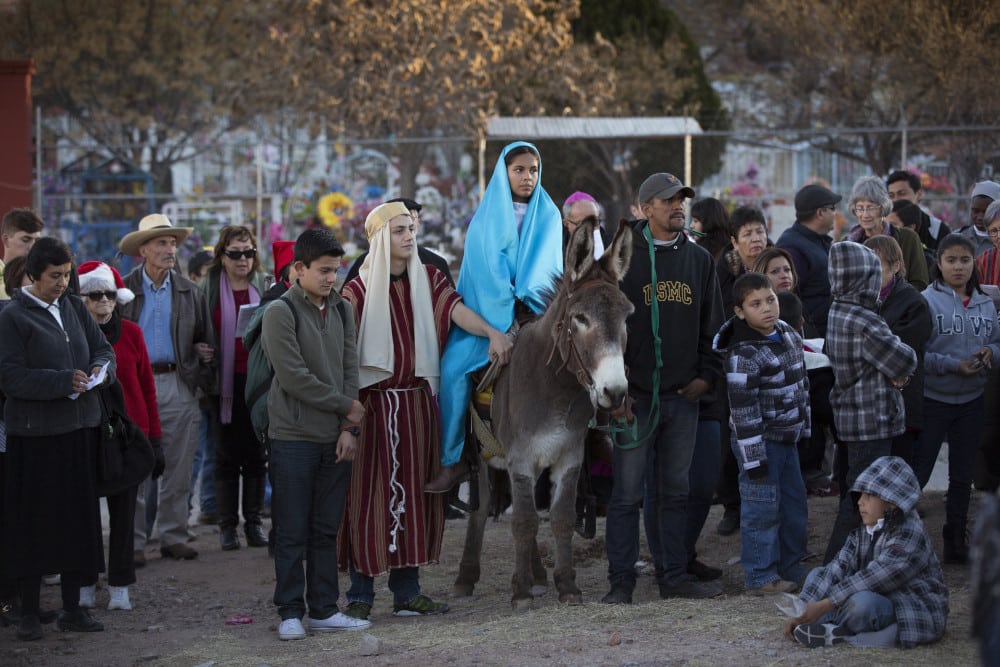

Six lay staff members from a now-closed diocesan Cáritas chapter were convicted on money laundering charges in Nicaragua on Christmas Eve as the Sandinista regime stepped up its crackdown on the Catholic Church over the Christmas season. The Nicaraguan government has also forbidden the enactment of traditional « posadas, » the living Nativity scenes created in the streets in the days leading up to Christmas.
The six convicted staff members previously worked for Caritas in the Diocese of Estelí — where imprisoned Bishop Rolando Álvarez of Matagalpa is apostolic administrator — which was closed in 2022 as part of the regime’s repression of church, charitable and non-governmental organizations. Nicaraguan media identified the six Caritas staff as Julio Sevilla, Julio Berríos, Bladimir Pallés, María Verónica Herrera Galeano, Freydell Andino and Mariví Andino.
The regime has revoked the legal status of more than 3,500 non-governmental organizations in recent years, including Caritas chapters and Catholic projects such as universities, arguing the groups often failed to comply with tax laws and governance rules.
Independent Nicaraguan news organization Confidencial reported in June 2023 that the National Police alleged money laundering involving a 2012 donation of $563,207 for a hospital from Catholic Relief Services, the international aid agency of the Catholic Church in the U.S., to Caritas in the Diocese of Estelí. The police also claimed to have found « hundreds of thousands dollars hidden in bags » at various locations, according to Confidencial.
The outlet cited diocesan sources, which confirmed the hospital was not built, but the funds were designated for other projects. A Catholic Relief Services representative was not immediately available for comment.
Frs. Eugenio Rodríguez Benavides and Leonardo Guevara Gutiérrez from the diocesan chapter of Caritas were « requested by the National Police » for its investigation, according to a diocesan statement May 22.
They were held in a seminary in the capital Managua, though Guevara returned to Estelí in October, according to media reports. Rodríguez was exiled to the Vatican on Oct. 18, along with 11 other priests, who had been detained after police and paramilitaries targeted clergy in a wave of detentions.
President Daniel Ortega and his wife, Vice President Rosario Murillo, have turned increasingly tyrannical as they tighten their grip on power in the Central American country and silence all dissenting voices — including priests and bishops.
Bishop Isidoro Mora of Siuna was arrested Dec. 20, according to independent Nicaraguan media, while traveling to a parish in his diocese to celebrate the Sacrament of Confirmation. His arrest followed a Mass celebrated in the Diocese of Matagalpa, where he voiced spiritual support from the Nicaraguan bishops’ conference for Álvarez. The government has yet to comment on Mora’s whereabouts.
Msgr. Óscar Escoto, diocesan vicar in Matagalpa, was taken by police from his residence at around midnight Dec. 21, according to news outlet Mosaico CSI, which covers Matagalpa. He returned to the diocesan residence the next day, but police remained outside, according to photos posted to X by Martha Patricia Molina, a Nicaraguan lawyer in exile, who has documented Catholic repression in the country.
Shortly before midnight on Dec. 24, the regime released another priest of the diocese, Fr. Jader Guido, second vicar of St. Peter Cathedral in Matagalpa, after almost 12 hours of detention.
« His sin: raising prayers for the bishop of the Diocese, Msgr. Rolando Álvarez, » Confidencial reported on Dec. 25.
Álvarez was convicted in February on charges of conspiracy and spreading false information after a trial in which he was not entitled to choose his own defense counsel. He was sentenced to 26 years in prison, but he has rebuffed all attempts at being sent into exile.
The Christmas crackdown has extended to prohibitions on religious celebrations and expressions of popular piety important to many in Nicaragua. Most recently, police visited priests to warn against organizing traditional posadas — public Nativity scenes with children portraying figures such as Mary and Joseph — according to Molina.
The police have announced that they will not allow outdoor posadas and that they will only be allowed inside churches.
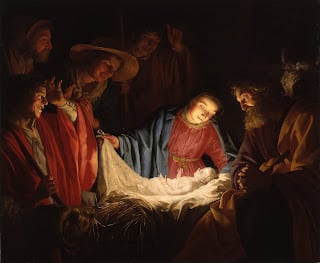
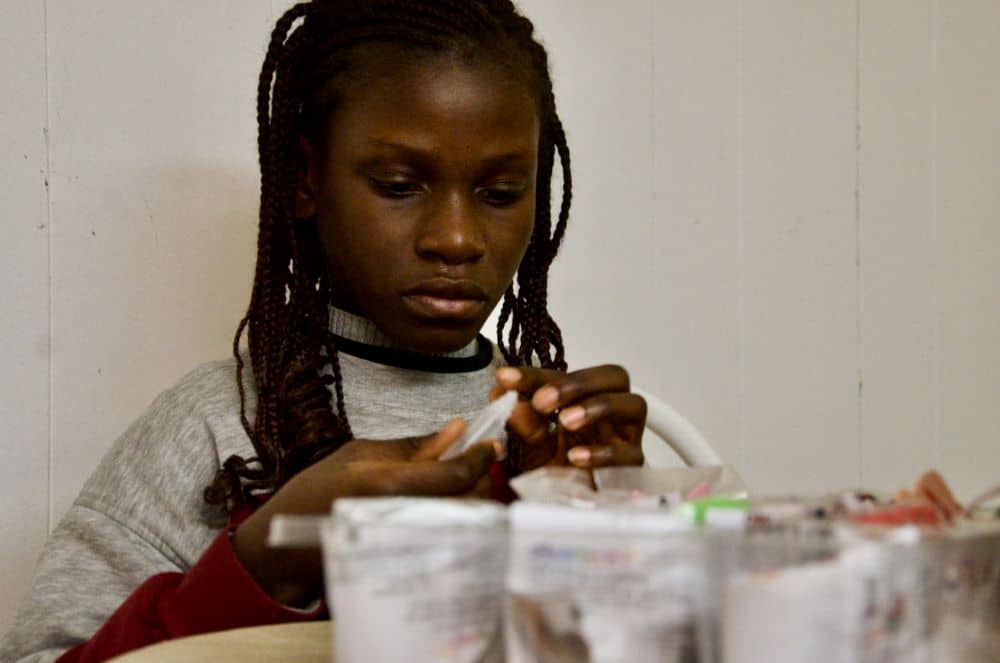

« En aquellos días, César Augusto promulgó un decreto por el que se debía realizar un censo en todo el mundo… Cada uno viajaba a su propia ciudad para ser empadronado ». (Lucas 2, 1-3).
Para Elizabeth, este lugar no es su hogar. Al menos, todavía no. Pero está muy agradecida de estar aquí, en un apartamento cálido en vez de en la calle o en algo peor.
El viaje de su familia desde Venezuela —mucho más arduo y peligroso que caminar los 112 kilómetros que separan Nazaret de Belén— comenzó hace más de un año. De hecho, en la Navidad de 2022, estaban tan cerca de su destino, Estados Unidos, que podían verlo desde el otro lado de la frontera mexicana. Sin embargo, aún no podían entrar en el país, porque seguía vigente la controvertida política del Título 42 que obligaba a los solicitantes de asilo a esperar fuera de Estados Unidos a que se tramitara su petición.
Y las Navidades de aquel año fueron horribles: echaban de menos a la familia que habían dejado atrás, vivían a la intemperie en tiendas de campaña y los niños estaban todos enfermos por el frío y con el sistema inmunitario mermado por haber caminado gran parte de los 4828 kilómetros.
Finalmente, voluntarios de Médicos Sin Fronteras trataron a los niños y alojaron a la familia en un hotel. En enero cruzaron a Texas, pidieron asilo y fueron trasladados en avión a Nueva York, donde Rosa, la sobrina de Elizabeth (Global Sisters Report solo utiliza el nombre de pila en este informe, ya que sus casos de asilo están pendientes), tuvo fiebre y debió ser hospitalizada.
Luego fueron trasladados en avión a Chicago, donde vivieron en un refugio hasta el 1 de agosto, cuando todo cambió.
« Y de repente apareció con el ángel una multitud de las huestes celestiales, que alababan a Dios y decían: ‘Gloria a Dios en las alturas, y en la tierra paz a todos aquellos sobre quienes recae su favor' ».
(Lucas 2, 13-14).
Las Hnas. de la Misericordia JoAnn Persch y Pat Murphy serían las primeras en decir que no son ángeles; pero ellas, junto con Carol Conway, asociada de su comunidad, y docenas de voluntarios y donantes, han trabajado duro para llevar paz y misericordia a los solicitantes de asilo.
En 2014 crearon el Comité Interreligioso para los Inmigrantes Detenidos, y en 2022 ya se estaban dedicando a otras tareas. Entonces empezaron a llegar los autobuses.
En agosto de ese año, el gobernador de Texas Greg Abbott comenzó a enviar autobuses cargados de solicitantes de asilo a ciudades que se habían declarado santuarios para los migrantes. La oficina de Abbott afirma que ha transportado a más de 50 000 personas al norte: más de 18 500 a Nueva York, más de 12 500 a Washington D.C. y más de 13 500 a Chicago.
Funcionarios de la ciudad de Chicago afirman que más de 25 000 inmigrantes han llegado en autobuses desde Texas, y otros 4000 lo han hecho en avión, desbordando los refugios y las ayudas de la ciudad. Associated Press informa que Nueva York ha recibido más de 120 000 solicitantes de asilo. No hay sitio en la posada ni en el refugio, ni en ningún otro sitio. El 1 de diciembre, cuando Chicago inició una gran campaña para acoger a los inmigrantes, más de 1000 vivían en comisarías de policía o en tiendas de campaña en las aceras de estas, preparándose para el brutal invierno de Chicago.
El 14 de diciembre, las autoridades de Chicago dijeron que el número se había reducido a 111 en las comisarías de policía y a otros 228 en el aeropuerto de O’Hare.
Persch y Murphy sabían que tenían que hacer algo, y Conway sugirió apadrinar a una familia. Asociados y hermanas de la Misericordia se comprometieron a hacer aportaciones mensuales para pagar el alquiler, y en octubre de 2022, una madre de Sierra Leona y sus cinco hijos estaban calientes, seguros y secos en un apartamento.
« Es simplemente abrumador. Pero estamos haciendo algo. No es ni siquiera una gota, pero es algo. Hace que sea más fácil dormir por la noche »: Carol Conway, asociada de las Hermanas de la Misericordia
Conway dijo que apadrinar a una familia parecía fácil.
« Una familia, sí podemos hacerlo », recuerda Conway. « Pero requiere no solo conseguir un apartamento, sino amueblarlo, escolarizar a los niños, conseguirles abogados de inmigración. [Persch y Murphy] sabían lo que había que hacer, pero yo no lo sabía », acotó.
« Cuando entraron en la casa, vieron al niño con María, su madre. Se arrodillaron y le rindieron homenaje. Luego abrieron sus cofres y le ofrecieron regalos de oro, incienso y mirra ». (Mateo 2, 11)
Pronto tuvieron una cuenta bancaria y se constituyeron como organización sin ánimo de lucro: Catherine’s Caring Cause, en honor a la fundadora de las Hermanas de la Misericordia Catherine McAuley. Hubo baches en el camino, pero, como dice Persch, no aceptaron « un no por respuesta ». También tienen amigos en las altas esferas, como el senador Dick Durbin, que asistió al 90 cumpleaños de Murphy. Y conocen a médicos, abogados y particulares que pueden hacer donaciones de 10 000 dólares.
« Dios es muy bueno con nosotras, esa es la verdad », dijo Persch, quien agregó: « Y, conocemos a mucha gente » desde hace mucho tiempo.
Persch, de 89 años, y Murphy, de 94, llevan ayudando a los inmigrantes desde la década de 1980, cuando empezaron a atender a personas que huían de la opresión y el terror en Centroamérica. La necesidad nunca pareció detenerse, y ellas tampoco. Sus voluntarios y simpatizantes parece que están dispuestos a acompañarles durante todo el viaje.
« Seguro que cuando tienes una familia, vas a tener dos », dijo Persch. A fecha de 13 de diciembre, tenían alojamiento para 12 adultos y 17 niños, pero eso también estaba a punto de cambiar. « Me olvidé de deciros », dijo Persch a Murphy y Conway, a quienes informó: “Hay una pareja y sus tres hijos alojados en un hotel donde tienen que vender caramelos en la calle y luego entregar el dinero. Nos los llevamos ».
Conway afirmó que a pesar de la controversia política sobre la afluencia de inmigrantes —algunos suburbios han prometido rechazar a los solicitantes de asilo—, la gente quiere ayudar, pero a menudo no sabe cómo.
« Es abrumador », afirma Conway. « Pero estamos haciendo algo. Ni siquiera es una gota, pero es algo. Hace que sea más fácil dormir por la noche », añadió.
« Un ángel del Señor se apareció a José en sueños y le dijo: ‘Levántate, toma al niño y a su madre, y huye a Egipto. Quédate allí hasta que yo te avise. Herodes busca al niño para matarlo' ». (Mateo 2, 13)
Isatu y su hermana pequeña Aminata son musulmanas y no celebran la Navidad. Pero en Chicago es difícil escapar de esta fiesta, así que en una tarde dorada de diciembre, Aminata se encuentra en la mesa de la cocina haciendo pequeños adornos de papel para un árbol de Navidad de cartulina. Cerca de ella hay un Corán.
Llegaron a Estados Unidos procedentes de Sierra Leona el 12 de mayo, y llevan en su apartamento proporcionado por Catherine’s Caring Cause desde el 1 de octubre, tras una estancia en Ohio y un refugio en el barrio Englewood de Chicago.
Como la Sagrada Familia, Isatu, de 22 años, y Aminata, de 10, huían de un terror dirigido contra ellas: la sociedad Bundu en la que vivían exige la mutilación genital femenina.
¿Cómo fue vivir bajo esa amenaza?
« Pensaba que iba a perder la vida o a no poder tener un hijo », dijo Isatu.
Así que Isatu lo dejó todo y huyó de Sierra Leona con Aminata, renunciando a su familia, a sus amigos y a todo lo que conocía. Pero ahora ella y su hermana pequeña están a salvo, y Aminata, de quinto curso, puede pensar en el libro que está leyendo, Diario de un niño travieso.
« Valió la pena », dijo Isatu.
Es difícil pensar en el futuro cuando tienes que preocuparte por las solicitudes de asilo y la ley de inmigración y por cómo ganarte la vida cuando no puedes trabajar legalmente, pero Isatu sabe lo que quiere hacer cuando estén realmente asentadas.
« Quiero estudiar Medicina y ayudar a las niñas de mi país », dice.
« Por tanto, se levantó, tomó al niño y a su madre, y partió aquella noche para Egipto, donde permanecieron hasta la muerte de Herodes ». (Mateo 2, 15)
El viaje de Belén a Egipto es de más de 643 kilómetros, y el terreno es implacable.
La Brecha o Tapón del Darién es solo un camino de 96 kilómetros en la frontera entre Colombia y Panamá, pero es un tramo de selva impenetrable y montañas de 1000 metros, cortado por ríos que de repente pueden convertirse en furiosos torrentes. No hay carreteras —es el único vacío en la carretera Panamericana— ni puentes; ni servicio de telefonía móvil ni comida; ni agua potable. El calor y la humedad son durísimos.
No hay médicos por si te hieren, lo que es una posibilidad real en el paisaje fangoso y montañoso, o para tratarte cuando enfermas por beber de un arroyo contaminado. Pero hay bandas armadas y delincuentes que roban, violan y matan a los emigrantes que logran cruzar. Cientos han muerto en el intento.
Incluso si consiguen llegar a la civilización, las condiciones son desoladoras: Bajo Chiquito, Panamá, el primer asentamiento que encuentran los emigrantes tras salir de la selva, es un pueblo minúsculo. Las agencias humanitarias han establecido allí centros de ayuda, pero los recursos, como baños y agua potable, son limitados. Las autoridades calculan que hasta 500 000 personas han hecho el viaje este año, desbordando los servicios en ambos extremos del camino.
Advertisement
Elizabeth y su familia tardaron tres días en cruzar, pero se puede demorar 10 días o más.
« Fue terrible », dijo Elizabeth.
Pero lo consiguieron, y aunque su apartamento no es suyo, sus muebles donados, al igual que gran parte de su comida —uno de los adornos navideños de su árbol aún tiene la foto de archivo que venía de la tienda—, están seguras y calentitas. Elizabeth y su marido Angelo están trabajando y saben que tendrán oportunidades que no existen en Venezuela: la tasa de inflación allí —la peor del mundo— fue de más del 400 % en 2017, de más del 45 000 % en 2018 y del 146 000% en 2019.
« Estamos muy contentos, seguros y agradecidos », dijo Elizabeth, con Murphy de traductora. « Estamos agradecidos de estar aquí por fin para celebrar la Navidad… Aquí se está mucho mejor », expresó.
Nota del editor: Este artículo fue publicado originalmente en inglés el 21 de diciembre de 2023.
